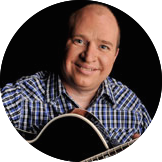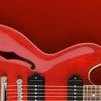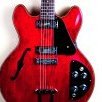Leaderboard
Popular Content
Showing content with the highest reputation on 08/03/2020 in all areas
-
Having been picked to choose this months recording challenge theme, I thought I would get going on a Jazz Standard. This is All of Me, straight out of the Real Book. I know we are going to study this one for the Jazz Standards Academy course, so I thought I would try it on my own first, and see the difference after Steve presents this in class. Thanks for any comments.3 points
-
Thanks @gotto and @Nutty 1 for your gracious comments and encouragement.1 point
-
When to use a "Lick" THE SHORT ANSWER: A lick's "usability" depends significantly on the musical context. What may work in one setting may sound awful in another setting. THE LONG ANSWER In your "notes are letters, licks are words" analogy, let me adjust something. Notes are letters, but licks are more like phrases than words. A word generally has one specific meaning but a phrase is much more dependant on context. And that's how it is with licks. For example, the phrase "Hey, buddy, you stink!!" may mean: "You don't smell very good." but it also could mean that "you're guitar playing needs some work." That's how it is with licks. For example, I could play a classic Stevie Ray Vaughn lick on my blues gig and people go wild. But I could also play the identical lick over the identical chords the next night at my jazz gig and get strange looks from everyone. THE MORAL OF THE STORY I wish a certain set of licks would be guaranteed to be great in any setting but it doesn't work that way - you've got to listen and use your ear as to what might work. That's why books like "100 Great Blues Licks" can only take you so far - you still have to apply those and adjust them to fit into a variety of musical settings.1 point
-
FIGURING OUT CHORDS There are quite a few ways to tackle identifying chords in songs... some more helpful than others. Let's have a look at a few of them. Using Bass Notes Listening for bass notes is, to me, the easiest way to identify chords. Since the role of the bass in pop in rock music is generally to lay down the foundation of the music, and play the root (primary note) of most chords, all the information we need to identify chords can often be found in the bass part. Try this: • pick a song that sounds relatively simple to play - one that doesn't move too quickly, and uses a basic strummed guitar part. • now, listen to the guitar part, and identify when the chords are changing in the song. • try to identify the bass part. The bass part in pop and rock music usually contains single notes, and is the lowest sounding instrument in the band. • using your guitar, try and identify what note the bassist plays when the guitar chord changes. Slide your finger up the sixth string of your guitar, and try every note, until you find one that sounds like the recording. • identify that note (eg. eighth fret on sixth string is a C) • try playing different types of C chords (Cmajor, Cminor, C7, etc) at that point in the song • when you find the right chord, move on to the next chord change This is a pretty solid method of figuring out songs, although several problems arise. Sometimes, bass players don't play the root note of the chord... for example, they may play the note E, when the chord is actually Cmajor. In time, you'll learn to identify these sounds immediately, but in the beginning, these sort of situations will certainly cause you some anguish. Suck it up! Identifying Open Strings This technique is particularly handy when you have tried the bass note method of figuring out a chord, and failed miserably. Hope you've been honing your skills at hearing open strings ringing, because it comes in handy here too! The concept is simple: listen for any open strings ringing in the recording, then find those same strings on your guitar. Now, rack your brain to remember all the chords you know that use those open strings, and try all of them, until you've found the proper chord. For example, if you were able to detect the open G and B strings ringing in the guitar part you were listening to, the chord could be an open G major chord, or an open E minor chord (actually, it could be a whole lot of chords, but we're keeping it simple here!) You would then try both chords, to see which one sounded correct. Note by Note Method This is admittedly a laborious method of figuring out chords, but sometimes, it's a necessary evil. The concept is simple... simply listen to the chord on the recording again and again, picking out any notes you can hear, and trying to replicate them on guitar. If you're lucky, after you get a couple notes, you'll recognize the chord. Sometimes, however, you just won't know the chord at all, so you have to put it together one note at a time. This can be extremely frustrating, but hey, no one promised this would be easy! And have faith that, while you're working, you're also training your ear, so next time, it will be a little easier. With just a little bit of knowledge, we can also make it mucheasier to anticipate what the chord *could* be, without even picking up a guitar to try and figure it out. We'll finish up by using basic theory to help figure out songs. The phrase "music theory" strikes terror into the hearts of many amateur musicians, and budding musicians the world over. Don't let those words scare you... while many think music theory is nothing but a bunch of dry, boring rules, the truth is, knowing some music theory can make your job as a guitarist much easier. Let's have a look at how knowing some theory can make figuring out songs much easier. Chords in a Key Let's get some straight facts out of the way first. There are 12 major keys, one for every letter of the musical alphabet (eg. Amajor, Bbmajor, Bmajor, Cmajor, etc.) Similarly, there are 12 minor keys (eg. Aminor, Bbminor, Bminor, etc.) A set of chords belongs to each of these keys. A song doesn't have to remain in one key... in fact, jazz and classical music very rarely stays in one key. Now, the good news. Almost all pop, country, rock, and blues music stays in one key throughout. Additionally, most of the music in these styles are written in the key of Cmajor, Dmajor, Gmajor, Amajor, Eminor, or Aminor. Why, you ask? Because the chords in these keys are easier to play on guitar, so songwriters tend to stick with them. Who wants to write a song in Dbmajor, and play a bunch of Db, Gb, and Ab chords when you could instead write the song in Dmajor and play D, G, and A? Explaining the chords in the following chart goes way beyond the scope of this article. Instead, attempt to do the following: • find out which key the song you're trying to figure out is in • Reference the below chart for that key, and see what chords are available (the key is highlighted in black - all chords beside it are the chords available in that key). • Experiment with the available chords in that key, until you find the correct one MAJOR KEYS I ii iii IV V vi vii bVII * C Dm Em F G Am Bdim Bb D Em F#m G A Bm C#dim C E F#m G#m A B C#m D#dim D F Gm Am Bb C Dm Edim Eb G Am Bm C D Em F#dim F A Bm C#m D E F#m G#dim G * this chord doesn't actually belong in the key, but is very commonly used MINOR KEYS i ii III iv v or V VI VII Am Bdim C Dm Em or E F G Dm Edim F Gm Am or A Bb C Em F#dim G Am Bm or B C D I can hear many of you asking "but.. how do I figure out what key the song is in?" Several ways... you could look at a couple chords in the song you know, look in the chart above, and see which key has those chords in it. Another simpler, very inaccurate method of guessing which key a song is in, is to assume the first chord in the song is the correct key. So, if the first chord in the song is an Eminor, you would guess that the song is in Eminor. While there is absolutely no theoretical reason for this to be true, most pop/rock music is rather simple, so it tends to be true more often than not. So there you have it... a good basis for learning to figure out songs on your own. It will be a slow going process at first, but if you try a little each day, I think you'll find that within a few weeks, you'll have learned a whole lot. For those interested in learning more about music theory, I can't recommend the excellent Mark Levine's excellent Jazz Theory Book highly enough. The book begins at a rudimentary level, and provides as much music theory as most people would care to know. The package delivered may be different than the one your receive, standard that things change over time. but since I have a few minutes spare I'll type it for you... Sessions: This course is broken into twenty "Session". Each Session builds upon the previous one, so it's generally best to follow them in order. Both guitar and musical concepts are introduced in a simple logical sequence. ----- Practice Time: For most students, twenty to thirty minutes of practice time five days a week is a good pace. Student will typically spend tow to three weeks on each Session before they are ready to move on. You will find an "Estimated Time to Learn" printed in your Lesson Book at the start of each new Session. These are estimates only and will vary widely. Work at your own pace. ---- The DVD's On the DVDs, each Session will have an extensive instruction time followed by a shorter workshop time. The concepts are first explained in the instruction time, and then you practice them in the workshop. It is not necessary to watch the instruction portion repeatedly each day. Once you have the concepts down, go straight to the workshop for your practice times. ---- The Workshop Time The workshop portion of each Session is meant to be used during your daily practice time. We will cover together the concepts discussed. Generally the workshop times will be 10-15 minutes in length and will practice the main points of the session. When you have a few minutes and are ready to practice, turn on the workshop and we will go over the material together, starting slowly and gradually progressing to where you need to be before moving on to the next section. --- The Lesson Book Your Lesson Book contains all of the songs, examples and exercises that appear on the DVD's. Follow along in the book as you watch the DVDs, take notes in it, and use it any time you don't want to practice in front of the television. You will also use it when practicing with the Jan Along CDs. --- Jam Along CDs: This is the fun part! The Jam Along CDs contain recordings of all the songs you will be learning in this course. Practice by playing along with the guitar part. You will notice that the guitar has been recorded in the left channel, so you can turn it down by adjusting the balance on your stereo. Once you do, you'll be "Jamming Along" with the band all on your own! --- Members-Only Website: More resources, bonus exercises and a discussion board for posting questions is available to you at w w w .. forum changed names [dot] com here. Don't miss this tremendous new resource available to you at no cost. And Finally.... A word of encouragement. You may have realized that it is likely to take a full year to get through all of these Sessions. That probably seems like a long time, but keep this in mind: You will become a guitar player long before you actually finish this course. You will be playing your first songs within a few weeks. A few weeks more and you'll have some basic chords. Within a few months, you'll be able to play most of the songs you hear on the radio. The "mastery" part of the Learn and Master Guitar does take a bit longer, but by then you will probably be having so much fun that the time won't matter. Of course, you may also choose not to go much beyond the basics. That's ok, too. Guitar "master" may or may not be your goal. Whatever your destination is, focus on enjoying the process. Take one step at a time, and above all else. Have fun with it.1 point





